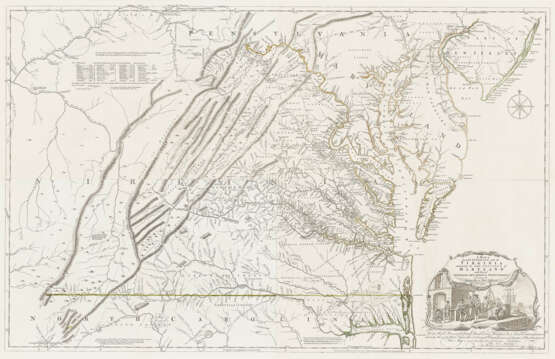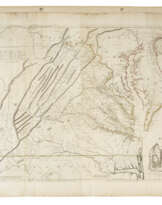ID 887924
Lot 146 | A Map of the Most Inhabited Part of Virginia
Estimate value
$ 8 000 – 12 000
Fry & Jefferson, 1775
VIRGINIA – FRY, Joshua and Peter JEFFERSON, cartographers. A Map of the Most Inhabited Part of Virginia. Containing the whole Province of Maryland with Part of Pennsilvania, New Jersey and North Carolina. [London:] Thomas Jefferys, [1775-1782].
The finest eighteenth century map of Virginia and Maryland. A landmark early American map, based on careful surveys by Fry and Jefferson (father of the future President), accurately delineating the boundaries, roads, settlements and Native trails, incorporating considerable new geographical information reported by early wilderness travelers including George Washington, Christopher Gist and John Dalrymple. Completed in 1751, it was engraved and published several years later. Eight different states are recorded by Pritchard & Taliaferro, of which this is state 6. It was issued in 1775 for inclusion in Thomas Jeffery's American Atlas, the most authorative atlas of America at the time of the American Revolution. Cumming, The Southeast in Early Maps, no. 281; Pritchard & Taliaferro, Degrees of Latitude, no. 30; Schwartz & Ehrenberg, p.157-158; Coolie Verner, "The Fry and Jefferson Map" in Imago Mundi, 21 (1967), pp. 74-94.
Engraved map hand-colored in outline, large engraved cartouche bottom right, comprising 4 engraved and joined sheets, together 785 x 1248mm sight size (the SW sheet slightly disjoint at nothern edge). Archivally matted, framed and glazed to 43½ x 60 inches. [With]: Three reference works pertaining to this map, 1967-2002.
4
| Artist: | Joshua Fry (1699 - 1754) Peter Jefferson (1708 - 1757) |
|---|---|
| Place of origin: | United Kingdom |
| Auction house category: | Maps & Atlases |
| Artist: | Joshua Fry (1699 - 1754) Peter Jefferson (1708 - 1757) |
|---|---|
| Place of origin: | United Kingdom |
| Auction house category: | Maps & Atlases |
| Address of auction |
CHRISTIE'S 8 King Street, St. James's SW1Y 6QT London United Kingdom | |
|---|---|---|
| Preview |
| |
| Phone | +44 (0)20 7839 9060 | |
| Buyer Premium | see on Website | |
| Conditions of purchase | Conditions of purchase |





